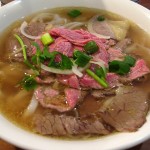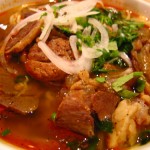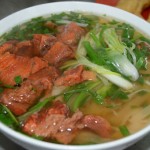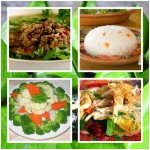Famous for its lively, fresh flavours and artfully composed meals, Vietnamese food and cooking is the true ‘light cuisine’ of Asia.
Plain rice ( com trang ) is at the center of the Vietnamese diet. Steamed rice is part of almost every meal. The Vietnamese prefer long-grain white rice, as opposed to the short-grain rice more common in Chinese cooking. Rice is also transformed into other common ingredients such as rice wine, rice vinegar, rice noodles, and rice paper wrappers for spring rolls.
Rice is also used to make noodles. There are four main types of rice noodles used in Vietnamese cooking. Banh pho are the wide white noodles used in the quintessential Vietnamese soup, pho . Bun noodles (also called rice vermicelli) look like long white strings when cooked. Banh hoi are a thinner version of bun noodles. In addition, there are dried glass, or cellophane, noodles ( mien or bun tao ) made from mung bean starch.
Present at all main meals and importance is the condiment added to most dishes at all times (just as salt is used in most Western dishes): “Nuoc Mam”. This is made from salt and fish well fermented. It is prepared in he own way with chili peppers, garlic and onions, vinegar and a sprinkle of citrus juice to heighten the tang.
Nuoc mam is produced in factories along the coast of Vietnam. Anchovies and salt are layered in wooden barrels and then allowed to ferment for about six months. The light-colored, first-drained sauce is the most desirable. It is also the most expensive and reserved primarily for table use. Less expensive nuoc mam is used in cooking. When shopping for nuoc mam , one should look for the words ca com on the label, which indicates the highest quality.
The most popular condiment is nuoc cham (dipping sauce), which is as common in Vietnam as ketchup is in North America. Saucers filled with nuoc cham are present at practically every meal, and diners dip everything from spring rolls to meatballs into it. Nuoc cham is quite simple to make and will keep in the refrigerator for up to 30 days. A few spoonfuls over a bowl of plain rice can be considered an authentic Vietnamese peasant meal.
Fish and other aquatic animals, such as squid and eel, are central to the Vietnamese diet. Beef, pork, and chicken are also important, but are consumed in smaller quantities. The unique flavorings in Vietnamese cooking are created with a variety of spices and seasonings, including mint leaves, parsley, coriander, lemon grass, shrimp, fish sauces ( nuoc nam and nuoc cham ), peanuts, star anise, black pepper, garlic, shallots, basil, rice vinegar, sugar, green onions, and lime juice. To provide a contrast in texture and flavor to the spicy meat components of a meal, vegetables are often left raw and cut into small pieces (usually cut at an angle, or julienne), especially in the south. Cool, crunchy foods include cucumbers and bean sprouts. The typical Vietnamese meal includes meat and vegetables, either eaten with chopsticks and rice or rolled into rice paper or (red) leaf lettuce and dipped into an accompanying sauce. Traditional preparation techniques are determined by eating habits, geography, and economics.
Food Words in Vietnamese
pho (fol) = soup
bo (ball) = beef
ga (gaw) = chicken
gao (gow) = uncooked rice
com (gum) = cooked rice
nuoc mam (nook mum) = fish sauce
bun (poom) = noodles
cuon (coom) = salad or lettuce
Soure: hoian-tourism.com
Post Views:
1,807







